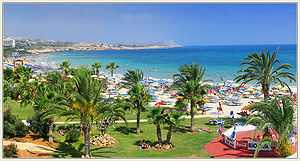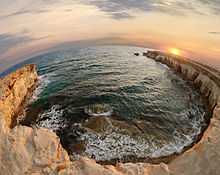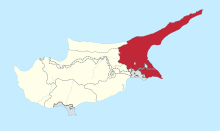Ayia Napa
| Ayia Napa | ||
|---|---|---|
| Αγία Νάπα (Greek) | ||
 | ||
| ||
 Ayia Napa Location of Ayia Napa within Cyprus | ||
| Coordinates: 34°59′N 34°00′E / 34.98°N 34.00°ECoordinates: 34°59′N 34°00′E / 34.98°N 34.00°E | ||
| Country |
| |
| District | Famagusta District | |
| Government | ||
| • Mayor | Yiannis Karousos | |
| Population (2001)[1] | ||
| • Total | 2,693 | |
| Time zone | EET (UTC+2) | |
| • Summer (DST) | EEST (UTC+3) | |
| Website | http://www.agianapa.org.cy/ | |
Ayia Napa (officially romanised Agia Napa; Greek: Αγία Νάπα [locally [aˈʝanːapa]]; Turkish: Aya Napa) is a resort at the far eastern end of the southern coast of Cyprus.
Etymology
The name Ayia Napa is derived from a Venetian-era monastery of the same name, located in the centre of the town, next to the square that today is the clubbing centre. The word "Ayia" (Agia) means "holy" in Greek. "Napa" is archaic and means "wooded valley" or dell. In ancient times the area surrounding the town was covered with thick forest.
History
According to local legend, the now renowned original icon was accidentally discovered by a hunter in pursuit of his prey. Upon discovery, the icon of the Virgin Mary was called Virgin Mary of Napa, eventually shortened and now known as Ayia Napa. The present monastery, built in 1100, was built around the cave, in honour of the Virgin Mary of Ayia Napa. According to local tradition, until 1790 no one lived within close vicinity of Ayia Napa. The first inhabitants were from Salonica, Greece. The name of the first inhabitant of Ayia Napa was Nikolaos Kemitzis from thesalloniki. he arrived from Greece around 1790 and got married to a village located on the northern east part of Ayia Napa and paralimni, the name of the village was panayia. soon after the marriage kemitzis had a fight with the ottoman authorities which ruled Cyprus at the time. and decided to move near the monastery of ayia napa.
Geography

Geographically, Ayia Napa lies near Cape Greco at the eastern part of Cyprus, just south of Famagusta and forms part of a larger area known as Kokkinochoria ("Red Villages", a name derived from the red colour of their soil). It is a town of Famagusta District, in the remaining southern part of the district occupied by Turkish forces in 1974. Ayia Napa is about 8 kilometres (5.0 mi) from Protaras, a town that has recently seen similar development, but still manages to remain low-key and remains more favourable for families and Cypriot locals.
Tourism


Ayia Napa attracts a large number of tourists, mostly British, Russian, Scandinavian, Greek, German, Swiss, Israeli and Lebanese, while in recent times there has been an increase in tourist arrivals from Italy, France, Serbia, Slovakia and Czech Republic, leading to a multicultural crowd in Ayia Napa and indicating an increase in Ayia Napa's popularity amongst people of various age groups from several countries in Europe and the Middle East. Ayia Napa features a number of bathing beaches, on which water sports such as water-skiing, windsurfing, canoeing, scuba diving and speed boating are popular. The Cyprus Tourism Organization (CTO) supervises the beaches and is responsible for protecting the interests of all tourists. The most popular of these beaches is Nissi beach on Nissi Avenue, which is very popular mainly with younger people in the summer and gets quite crowded; it offers great water sports facilities as well as a beach bar which plays music throughout the day and offers events such as foam parties and games. Another is the Harbour beach (also known as Limanaki (CTID) or Pantahou beach), which is one of Cyprus' longest beaches, and the longest in Ayia Napa. Harbour beach caters more for families. The New Golden Bay (or Lanta / Landa beach as it is known to the locals) is less crowded, but there are still a number of activities available. All 14 beaches in Ayia Napa have been awarded the EU blue flag for their level of cleanliness and facilities. Cyprus, with 53 Blue Flag beaches, has three records:
- the most Blue Flags per capita in the world
- the most dense concentration of Blue Flag Beaches
- the most Blue Flag beaches and per coastline length in the world.
Beach parties are another popular form of entertainment in Ayia Napa, often featuring headlining acts from the UK House and Grime scene, such as Example (musician), DJ Fresh, Lethal B, Tempa T & Boy Better Know, while more recently there have been other more internationally acclaimed acts such as Tyga, LMFAO, Flo Rida and Dimitri Vegas & Like Mike. These beach parties mainly take place at Makronissos Beach Club near the Waterpark and the upcoming Ayia Napa Marina; the beach has come to be known as Kandi Beach as of late due to the name of the beach parties that regularly take place there.
Several hotels and apartments are situated on Nissi Avenue, the main road of Ayia Napa, including Nissi Beach Hotel & Kaos Hotel Apartments amongst others, in addition to a large number of cafes/restaurants and bars, offering various cuisine types to visitors including local taverns with Cypriot cuisine, Pizza places, Steak Houses, Pubs offering English Breakfast, Chinese Restaurants etc. On the end of Nissi Avenue is Archiepiskopou Makariou III Avenue, another main road in Ayia Napa, offering lots of high-end cafes & bars, the "I Love Ayia Napa" monument, Square and Bar Strip on its upper end and the Ayia Napa Harbour and Harbour Beach (Limanaki) on its lower end.
The Square, central to the town, is filled with restaurants, night clubs and shops, such as The Castle Club (often featuring in DJ Mag's Top 100 Clubs in the world list), Club Sin, Black & White, Nightmare-horror maze and Nikitas' Steak House. Ayia Napa has changed its image somewhat over the years, from a fishing village to a typical Mediterranean resort and has now found its place as a multicultural town, catering for all tastes. Ayia Napa has strict laws on the use of laughing gas and throughout the years almost everyone caught using it has been arrested. If found using laughing gas tourist can face up a minimum of 1 year in prison and has to be carried out within the country of Cyprus.
Cape Greco national park is a ten-minute drive from the centre of Ayia Napa and is considered one of the most beautiful places on the island offering sightseeing, cliff jumping, bike riding and a variety of other activities. It is one of the most famous spots in Cyprus for the lovers of photography due to its picturesque nature, caves, cliffs, clear waters and trees. You will often see couples who just got married taking their wedding photos in various spots around Cavo Greko, such as the old tree in the entrance, Crow's bridge, Ayioi Anargiroi Chapel, Blue Lagoon, and also Konnos Bay, a beach surrounded by mountains and naturally a favorite with both locals and tourists due to its beauty and the fact that it is generally quiet. It is also known for being shared between Ayia Napa and Protaras, split down its middle with an imaginary border.

Shopping
Cyprus is known for its handicrafts and boutiques. While in Ayia Napa, the shops are interspersed with outlets selling designer sunglasses and watches. A large number of clothing shops have recently opened on Nissi Avenue and Archiepiskopou Makariou Avenue.
Monastery

Ayia Napa Monastery is the best known landmark of the Ayia Napa area. It has a charm that represents a time when Ayia Napa was a sleepy fishing village. It seems that in ancient times, the location where the monastery and the village exists today, was covered by thick forest, visited only by hunters from the neighbouring villages.
Museums, Ruins, Arts and Culture
The town contains a number of museums. The Tornaritis - Pierides Museum of Marine Life was founded in June 1992 in Ayia Napa and is located at the lower level of the Town hall. It exhibits past and present marine life, scientifically classified. Its main purpose is to show the marine fauna of Cyprus and the Mediterranean, helping the study and research of this part of Natural History, but also to stress the importance and necessity of preserving the marine environment.
Thalassa, the Municipal Museum of the Sea in Ayia Napa, is dedicated to the enhancement, promotion and preservation of the marine heritage of Cyprus, from prehistoric times to the present. Located at the centre of Agia Napa, the Museum displays marine artifacts and serves as a centre for educational programmes and community cultural events. The Museum houses sculptures, engravings, ceramics and paintings of seascapes made by some of the greatest 19th and 20th century Greek and Cypriot artists.
The Makronissos Tombs are found west of Ayia Napa village. They are an ancient burial site, located at a stepped road, which leads down to a rectangular entrance. The entrances were originally closed with one large or two smaller calcarenke slabs.
The Ayia Napa Sculpture Park, which is located in the east side of Ayia Napa, was recently completed. an initiative of the young mayor Yiannis Karousos under his strategy complete tourist experience. the sculpture park was inaugurated in May 2014 with the organisation of the 1st Sculpture Symposium of Ayia Napa. 17 sculpts were created on the site with participation's from Cyprus and Greece. the municipality now continues to the organisation of the 2nd Symposioum, which now has received an international Status with participants from Europe, US, Middle East and Cyprus.
Festival
The Ayia Napa Festival was first held in September 1985 and has been established as an annual event since, usually over the last weekend of September. It takes place in Sepheris Square in Ayia Napa Monastery. The festivities reflect the historic, cultural and agricultural traditions of Ayia Napa and Cyprus as a whole. The programme includes theatrical performances, operas, concerts and Cypriot and foreign folk dancing. Famous artists visited the festival such as Nana mousxouri, Marios frangoullis, Viki Leandros, George Dalaras, the Tenors of the 21st Century of Moscow
Ayia Napa Youth Festival
The Ayia Napa Youth Festival was established in 2010[2] when the Ayia Napa youth council, accepted the proposal of its president Yiannis Karousos and decided to organise a festival similar to the large music festivals of Europe, combining activities and music. The festival is based on several principles such as free entrance, the headliners to be chosen by the public, a charity goal, a social responsibility message attached to it; all styles of music are welcome. At the first festival which took place at the harbour square of Ayia Napa more than 10,000 people visited the festival during the three-day period with bands such as the Greek reggae act Locomondo, the pop-rock band MPLE and the hip hop band Stavento featuring Ivi Adamou. Also 25 bands performed, most of them in the music styles of rock and metal. In 2011 the Ayia Napa Youth Festival became international and included the band Stratovarius, Sabaton, Rotting Christ, Nightstalker, and 20 bands from all over Europe and Cyprus. The 3rd Ayia Napa Youth Festival took place on 24 and 25/9 2012 with popular rock artists on its roster such as Vasilis Papakonstantinou, Katsimixa brothers, Nighstalker and many other bands from Malta, Greece and Cyprus.
Waterworld Themed Waterpark
The Ayia Napa Waterworld Waterpark is the biggest themed waterpark in Europe.[3] Waterworld Waterpark in Ayia Napa has received international recognition for marketing and innovation from a spectrum of the Waterpark associations around the world winning over 25 awards to date. In the Greek mythology-themed waterpark there are upgraded attractions, extensive relaxation areas for parents and playground areas for children. It also has several catering outlets and a gift shop. Waterworld is open 7 days a week during the Summer season.
World record
Following the proposal of Mayor Yiannis Karousos,[4] then President of the Ayia Napa Tourism Committee, on September 16, 2007, the world's longest chain of syrtaki dancers (an ostensibly traditional Greek dance) danced to Zorba the Greek in a successful attempt to enter the Guinness Book of World Records. The chain had a total of 268 members of eight groups dancing in step to Zorbas. Then Ayia Napa Mayor Antonis Tsokkos said the aim of the event was to send the message that the village was interested in Greek culture and to promote the tourist resort abroad. Head of the cultural services of the Municipality Maria Tofini said that according to the Guinness Book of World Records, the dancers had to perform in synchronised step for the attempt to qualify. The event drew the attention of tourists and locals, many of whom danced to Zorbas on the beach and in the sea.[5] This record has since been lost but there will be another attempt to reclaim it on September 28, 2014, as part of the Ayia Napa Festival activities. The attempt will take place on Archiepiskopou Makariou Avenue and the dances that will be performed will be the Greek "Zorbas" and "Kalamatianos" dances as well as the Russian "Kalinka" dance. The event is expected to draw the interest of many locals and tourists alike, in addition to professional dancing groups who will take part in the attempt.
The Ayia Napa Walk of Fame - Square
In order to honor the famous personalities and artists which visited and still visit Ayia Napa, the City of Ayia Napa in 2013 has inaugurated the Ayia Napa Fame Square. Famous Singers, Djs, Artists, Politicians are inducted to this square. The idea was based under the Complete tourism experience strategy which the municipality of Ayia Napa is following. Artists such as Psarantonis, Mario Frangoulis, the Tenors of the 21st Century, Tiesto, Paul Van Dyk are just a few of the stars placed. the star square was created in the city center under an effort to attract visitors by creating points of interests in the city center.
International relations
Twin towns – Sister cities
Ayia Napa is twinned with:
Gallery
-

-
Nissi beach
-

Tourists at Ayia Napa
-
Ayia Napa amusement park
-

Ayia Napa beach
-

Port of Ayia Napa
References
Proposals of Yiannis Karousos - Guinness Records for Ayia Napa
External links
| Wikivoyage has a travel guide for Ayia Napa. |
| Wikimedia Commons has media related to Agia Napa Monastery. |
| Wikimedia Commons has media related to Agia Napa. |
| ||||||||||||||||||||||||||



